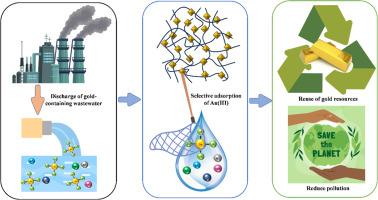壳聚糖-互渗金属有机骨架定向回收电镀金废水中的金
IF 12.4
1区 环境科学与生态学
Q1 ENGINEERING, ENVIRONMENTAL
引用次数: 0
摘要
随着原生金矿开采需求的增加、难度和成本的提高,从工业废水中回收黄金变得越来越重要。我们报道了一种壳聚糖互穿Zr-MOF (CS@MOF-TPA),它保留了壳聚糖- nh2键,同时显着增加了比表面积,克服了传统交联方法中遇到的稳定性和功能性之间的权衡。在MOF连接剂中引入三嗪-N/- nh2连接剂,增加了N/O给体位点的密度。CS@MOF-TPA在2-8的pH范围内工作(最佳pH值为5),在298、308和318 K下的吸附量分别为359.24、473.27和556.33 mg/g。吸附平衡符合Sips等温线,动力学符合拟二次/Elovich模型,表明其为非均相化学吸附。在混合离子溶液中,金的去除率可达99.39%,在实际电镀废水中,金的去除率可达68.88%。经5次硫脲再生后,吸附剂的吸附效率仍为90.96%。XRD/XPS和DFT (DOS/PDOS, ELF, IGMH)分析支持静电辅助N/O位点配位是主要捕获途径。本文章由计算机程序翻译,如有差异,请以英文原文为准。

Chitosan-Interpenetrated Metal Organic Framework for Targeted Recovery of Gold from Gold-Electroplating Wastewater
With increasing demand and the rising difficulty and cost of primary gold mining, gold recovery from industrial wastewater is becoming increasingly important. We report a chitosan interpenetrating Zr-MOF (CS@MOF-TPA) that retains chitosan-NH₂ bonds while significantly increasing the specific surface area, overcoming the trade-off between stability and functionality encountered in traditional cross-linking methods. Triazine-N/-NH2-linkers are introduced into the MOF linker, increasing the density of N/O donor sites. CS@MOF-TPA operates within a pH range of 2-8 (optimum at pH 5), with adsorption capacities of 359.24, 473.27, and 556.33 mg/g at 298, 308, and 318 K, respectively. The adsorption equilibrium follows the Sips isotherm, and the kinetics fit the pseudo-secondary/Elovich model, indicating heterogeneous chemical adsorption. Gold removal efficiency reaches 99.39% in mixed ion solutions and remains as high as 68.88% in actual electroplating wastewater. The adsorbent retained an adsorption efficiency of 90.96% after five thiourea regeneration cycles. XRD/XPS and DFT (DOS/PDOS, ELF, IGMH) analysis supported electrostatically assisted coordination of N/O sites as the primary capture pathway.
求助全文
通过发布文献求助,成功后即可免费获取论文全文。
去求助
来源期刊

Water Research
环境科学-工程:环境
CiteScore
20.80
自引率
9.40%
发文量
1307
审稿时长
38 days
期刊介绍:
Water Research, along with its open access companion journal Water Research X, serves as a platform for publishing original research papers covering various aspects of the science and technology related to the anthropogenic water cycle, water quality, and its management worldwide. The audience targeted by the journal comprises biologists, chemical engineers, chemists, civil engineers, environmental engineers, limnologists, and microbiologists. The scope of the journal include:
•Treatment processes for water and wastewaters (municipal, agricultural, industrial, and on-site treatment), including resource recovery and residuals management;
•Urban hydrology including sewer systems, stormwater management, and green infrastructure;
•Drinking water treatment and distribution;
•Potable and non-potable water reuse;
•Sanitation, public health, and risk assessment;
•Anaerobic digestion, solid and hazardous waste management, including source characterization and the effects and control of leachates and gaseous emissions;
•Contaminants (chemical, microbial, anthropogenic particles such as nanoparticles or microplastics) and related water quality sensing, monitoring, fate, and assessment;
•Anthropogenic impacts on inland, tidal, coastal and urban waters, focusing on surface and ground waters, and point and non-point sources of pollution;
•Environmental restoration, linked to surface water, groundwater and groundwater remediation;
•Analysis of the interfaces between sediments and water, and between water and atmosphere, focusing specifically on anthropogenic impacts;
•Mathematical modelling, systems analysis, machine learning, and beneficial use of big data related to the anthropogenic water cycle;
•Socio-economic, policy, and regulations studies.
 求助内容:
求助内容: 应助结果提醒方式:
应助结果提醒方式:


